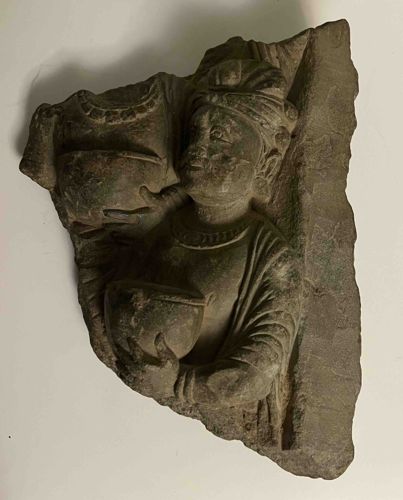
Ancient Stone Architectural Fragment with Figural Carving
This is a fragment of a stone carving, likely from a larger architectural or sculptural relief, measuring approximately 10-12 inches in height and 8-10 inches in width at its widest points. The material appears to be a type of dark grey or brown sandstone, exhibiting a heavily weathered and aged patina with visible greenish-grey discoloration, possibly from moss or environmental exposure over centuries, particularly in recessed areas. The fragment depicts two figures, one prominently featured in the foreground and a partial figure behind it. The main figure is a bust of a human-like individual, possibly male, wearing an elaborate headdress or turban with decorative elements visible around the forehead and temples. The figure's face has softened features due to wear, but discernible eyes, a nose, and lips are present. The ears are also somewhat visible. The figure is depicted holding what appears to be a small, round bowl or cup in both hands, positioned at chest level. The clothing of the main figure is simple, with long sleeves and a high neck, suggesting a tunic or robe. The craftsmanship suggests a hand-carved piece, with some level of detail preserved in the headdress and the folds of the drapery, despite significant erosion. There are no clear maker's marks or signatures visible. The edges of the fragment are irregular and broken, indicating it was once part of a larger composition. The overall style, including the attire, facial features, and the nature of the carving, suggests an origin from Indian subcontinent or Southeast Asia, possibly dating back to ancient or medieval periods (e.g., Gupta, Pala, Khmer, or similar classical styles), likely pre-15th century due to the observed wear and artistic style. The robust material and carving technique indicate it was built for outdoor or permanent architectural integration. The condition shows heavy weathering, chips, abrasions, and loss of finer details, consistent with significant age and environmental exposure. No obvious repairs are apparent, and the visible damage appears consistent with natural aging and breakage from a larger structure.
AI-Generated Appraisal Disclaimer
Estimated Value
$1,500 - $2,500
Basic Information
Category
Sculpture/Architectural Fragment
Appraised On
December 7, 2025
Estimated Value
$1,500 - $2,500
Item Description
This is a fragment of a stone carving, likely from a larger architectural or sculptural relief, measuring approximately 10-12 inches in height and 8-10 inches in width at its widest points. The material appears to be a type of dark grey or brown sandstone, exhibiting a heavily weathered and aged patina with visible greenish-grey discoloration, possibly from moss or environmental exposure over centuries, particularly in recessed areas. The fragment depicts two figures, one prominently featured in the foreground and a partial figure behind it. The main figure is a bust of a human-like individual, possibly male, wearing an elaborate headdress or turban with decorative elements visible around the forehead and temples. The figure's face has softened features due to wear, but discernible eyes, a nose, and lips are present. The ears are also somewhat visible. The figure is depicted holding what appears to be a small, round bowl or cup in both hands, positioned at chest level. The clothing of the main figure is simple, with long sleeves and a high neck, suggesting a tunic or robe. The craftsmanship suggests a hand-carved piece, with some level of detail preserved in the headdress and the folds of the drapery, despite significant erosion. There are no clear maker's marks or signatures visible. The edges of the fragment are irregular and broken, indicating it was once part of a larger composition. The overall style, including the attire, facial features, and the nature of the carving, suggests an origin from Indian subcontinent or Southeast Asia, possibly dating back to ancient or medieval periods (e.g., Gupta, Pala, Khmer, or similar classical styles), likely pre-15th century due to the observed wear and artistic style. The robust material and carving technique indicate it was built for outdoor or permanent architectural integration. The condition shows heavy weathering, chips, abrasions, and loss of finer details, consistent with significant age and environmental exposure. No obvious repairs are apparent, and the visible damage appears consistent with natural aging and breakage from a larger structure.
Related Tags
Explore similar items and categories:
Get Your Items Appraised
Instant estimates of your treasures with AI-powered instant appraisals